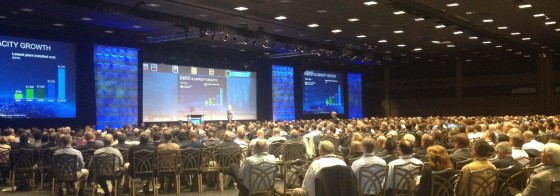
Las Vegas Convention Center
As we finish 2015 and come into the new year, now seems an appropriate time to reflect on what happened over the last 12 months and what we can expect in the coming year. In the second week of December (12/6-12/10) 21,000 energy professionals met in Las Vegas for the annual Power Generation Week. The conference was a series of energy conferences compiled of 5 events thrown at the Las Vegas Convention center. Led by Power Gen International (PGI) – the largest conference and expo for the traditional power generation industry – the event also featured the Renewable Energy World Conference and Expo, Nuclear Power International, Coal-Gen and the Gen Forum. It was a highly informative and collaborative week of technical tours, conference sessions, networking events and much more. I was lucky enough to attend – however, if you missed out here is the top news and insights from the event.
Las Vegas to Achieve 100% Renewable Energy for City Operations

Photo Credit: Brisan
The first piece of news was an announcement made just two weeks prior, when the city of Las Vegas and Berkshire Hathaway Inc.-owned NV Energy (also a utility sponsor for the event) announced a new partnership that could take the city to a new level of environmental sustainability by drastically increasing the generation of renewable energy. The proposal still requires the approval of a filing to the Public Utilities Commission of Nevada, and approval from the Las Vegas City Council yet under the proposal all municipal buildings, fire stations, parks, streetlights, and other facilities in Las Vegas will be powered entirely by clean energy. The power will be supplied by a portion of the 100 MW (AC) Boulder Solar power plant currently under development in the Eldorado Valley of Boulder City, Nevada. Construction for the plant is being completed by SunPower. The energy dedicated from this solar facility, and the power that the city receives from NV Energy already satisfies the state’s renewable portfolio standard and now the partnership will allow the city of Las Vegas’ retail load to be served 100 percent by renewable energy. Although the agreement doesn’t cover the famously bright, privately owned casinos on the Las Vegas Strip, it is still a very encouraging move from the council and a sign that renewable generation becoming increasingly competitive with electricity produced from fossil fuels. Las Vegas Mayor Carolyn Goodman proudly stated that “We will become the first city of our size in the nation to achieve 100 percent renewable energy for city operations”.

Trade show floor at Power Generation Week 2015
In addition to some of the large scale utility and policy news shared during the keynote speeches, the event also had one of the largest trade show floors I’d ever seen. With interesting technologies shown through interactive displays and product demos, there was an endless array of innovation such as Kubota Engine America Corp. (KEA) who was debuting one of their new product lines. Attendees at Power Generation Week 2015 had the opportunity to get an exclusive look at KEA’s BG Engines for Emergency Stationary Standby Gensets. The line is Kubota’s first complete package and expands the company’s reach in the power generation market.
Clean coal? Is it possible?
While most of the focus was on renewables and their applications one discussion that I found interesting was the efficiency leaps being made with coal power generation. Seeing as coal fuels account for 40 percent of the world’s electricity generation and is approaching oil as the world’s largest energy source, I was intrigued by Peabody Energy who have honored coal-fueled power plants for top global and U.S. environmental performance with its Advanced Energy for Life Clean Coal Awards. Global award recipients include Dynegy Inc. in the United States, Korea Southeast Power Co. (KOSEP) in South Korea, and Trianel Kohlekraftwerk Lünen GmbH & Co KG (Trianel) in Germany. These power plants all displayed a significant reduction of emissions from traditional coal powered power plants. One such example operating in Central Illinois is Dynegy Inc.’s Coffeen Plant which has been honored both globally and in the United States for the lowest emissions profile for SO2 has an SO2 emissions rate that is 99 percent lower than the U.S. coal plant average. “At a time of heightened global discussion about the benefits of advanced coal technologies, Peabody is proud to showcase clean energy solutions that achieve meaningful emissions improvement,” Peabody Energy President and Chief Executive Officer Glenn Kellow said. “These plants are demonstrating the best results worldwide and offer a powerful model to achieve our global environmental goals.”. So although most would agree that coal fired power plants are an inferior long term solution to renewables such as solar and wind, I found it encouraging to learn that even existing power plants were improving in environmental performance as we make the transition to more widespread renewable generation.
Nuclear Power in Canada
Another discussion I found interesting about the Nuclear Power generation in Ontario, Canada. I learnt that Nuclear Power provides more than 50% of electrical energy in Canada’s most populous province, Ontario. With export sales of $1.2B per annum the Nuclear Power in Ontario contributes over $5B/year to the Canadian economy and responsible for 30,000 direct jobs – highly skilled, technical and professional. Ontario is the world’s second largest producer of uranium, producing 10,000 tonnes/year, and the OCI claim that because of the Nuclear Power generation 90 million tonnes of GHG emissions are avoided annually in Ontario. On the tech side of things, I was interested when I saw an Internet of Things (IOT) application with portable power generators. ZTR have been able to decrease downtime and reduce the operational costs of monitoring power generation equipment with the i3 Network. This allows you to access real time data from rental generators so that you can track usage based on actual equipment use. Additionally the technology allows you to access Remote Diagnostics so you can know what the issue is and take the right tools and parts on the first trip.
Microsoft Signs 20 Year PPA for Solar
Finally there was discussions about the GE Energy Financial Services’ announcement from this earlier that week. EDF Renewable Energy’s 175–megawatt (MW) Pilot Hill wind project located in Kankakee and Iroquois Counties in Illinois has closed structured equity financing from GE Unit (NYSE:GE) GE Energy Financial Services and MetLife, Inc. (NYSE: MET). The project, which has achieved commercial operations and is located about 60 miles southwest of Chicago, will power 100 percent of the energy needs of Microsoft Corporation’s Chicago data center. Microsoft has committed to purchase the output under a 20-year power purchase agreement. This is Microsoft’s second and largest wind energy deal which demonstrates its commitment to a neutral carbon footprint. “Pilot Hill serves as another example of EDF Renewable Energy’s strategy to develop renewable energy projects with first tier equipment suppliers and contractors, and then invite the investment from longstanding financial partners,” said Jim Peters, Vice President, Project Finance for EDF Renewable Energy in a statement. “EDF RE will manage the wind project and bring our expertise in operations and maintenance through EDF Renewable Services to optimize long-term investment profitability.” Microsoft still has a long way to go to keep up with Google as to having renewable generation however the move is encouraging to see.
Become an ECO founder
Start the 30 day ECO founder Challenge (it’s free!) to learn how to startup your own clean technology business.
No spam, ever. You can unsubscribe at anytime.



